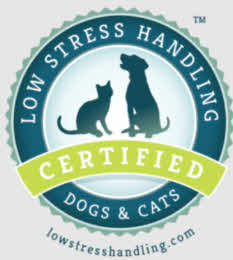Low Stress Handling™ has moved from a handful of professionals using the Low Stress Handling, Restraint and Behavior Modification of Dogs & Cats textbook, to more than a thousand Low Stress Handling™ Certified professionals. For some workplaces, changing animal care to a Low Stress culture has been an exciting change, with clear objectives and training. For other, a divide has erupted as Low Stress Handling™ techniques are resisted by some of the staff. As a speaker and writer promoting positive veterinary exams, I hear the frustration from those who experience the benefit of Low Stress Handling and find resistance to changing handling practices at their workplace. I want to share some insight into this problem and a few solutions.
Low Stress Handling™ is a culture change in the animal care industry – it turns the handling concepts from firm restraint, to reduced fear and cooperation based on animal behavior knowledge. Using Low Stress Handling™ requires one to work through the animal’s perspective, not one’s own. You must shift from task focused work – taking a blood sample or expressing anals – to the animal’s experience as you perform this task. In other words, the patient’s behavioral health in receiving care is as important as their physical health. Once you see the care experience through the animal’s perspective, empathy is awakened, and you cannot go back to former ways of force and restraint. A person who is educated in and using Low Stress Handling™ understands how fear and anxiety leads to aggression. The struggling, growling, hissing animal is not a spoiled or dominant animal. They are confused, forced, or sick animals who do not understand what we are going to do to them. Once handling is based on understanding their behavior, then we gain trust from the animal and cooperation for care. Experiencing this trust from an animal is thrilling – so why are some of our colleagues resistant to change?
Changing culture in a workplace is not easy, no matter how morally, scientifically, or ethically important it is. At best, it can take years to change an individual business’ culture. (See Footnote below) Changing the profession may take a generation of new professionals. Do not be disheartened, there are ways to create change in your practice while not losing your mind. I want to share with you, what I have discovered through interviews about the why’s, where’s and how‘s of this resistance to use Low Stress Handling™. By understanding the points of resistance, you can start to create a plan for approaching it in your workplace.
I use the term “North/South workplace” because the situation reminds me of the passion both sides had for their values during our Civil War. In the Civil War, both the North and South were passionate about their culture, beliefs and home. The passion of the Low Stress Handlers seeking to change their practices, coupled with the firm resistance from other members of the staff, draws a similar image to the Mason-Dixon line that split our country in two. Both sides are firm in their convictions and that creates a barrier. There are, however, ways to break through this line without a war. Here are some insights and methods that may help you if you are in a North/South practice.
I have used the term “traditional handling” to define the use of manual restraint focused on preventing injury to the person administering care. An example of this would be 2–3 people holding down a struggling dog for a nail trim, or scruffing a cat to remove it from a cage or during a blood draw. These handling practices have been used for many years and there are multiple text books demonstrating these handling techniques which are still used by technical colleges. The Low Stress Handling, Restraint and Behavior Modification of Dogs & Cats text book, by Dr Sophia Yin, is in use by many colleges, but it is not currently the standard of handling education.
One point of resistance comes from holding onto tradition, security in experience, and pride in one’s education. If a person spent 2–4 years earning a degree and was educated only in traditional handling, to challenge those methods is to challenge their entire education. I have personally experienced this in my practice. My three technicians, who graduated from the local technician college, have since learned and now use the Low Stress techniques, but they shared with me the dilemma they personally felt when they saw that what they learned in college was the opposite of what I was asking them to do. I was very direct as an employer in making it a job requirement to use Low Stress Handling™. At a staff meeting I listened to their mixture of feelings to being challenged personally, then acceptance of the benefits of Low Stress Handling™ and realizing that their handling education was counterproductive. Iacknowledged that I was creating a for them that I had to support them through. These three technicians are some of the strongest supporters of behavior education for technicians and of using only Low Stress Handling™ techniques for all patients. As a change leader, I had to understand their foundation in “traditional handling” in order to give them time to practice, and the opportunities to voice their concerns as this method was flying in the face of conventional teachings. I paced this change with handling technique goals. We took it step by step, and having this openness about change sped up the process. If this is your situation, a statement like “I can understand how you would question the authority of one book as compared to a degree program. You paid money for that degree, were tested and had to pass a state exam to gain your license. If you consider that new information comes from the field, not academia, would you be willing to try out a new technique or watch someone else to see how it works here?” This person must have a safe place to make a mistake and not feel like they do not know what they are doing. Practice sessions with stuffed animals or the pets of staff during slow times are the best approach here.
Another point of resistance can come from not having a foundation in the subject, and being overwhelmed by having to add this training and knowledge. While Low Stress Handling™ is based in the science of behavior, behavior is not a standard of education in our veterinary or technical curriculum. These veterinary staff do not have a foundation to build upon. For those colleges that do incorporate behavior education, there is far less resistance to utilizing Low Stress Handling™. Ask your staff what they know about animal behavior and you may find they only know punishment based training, or that treats are detrimental to the animal’s health. If this is your situation, start posting the Body Language of Fear in Dogs and Body Language of Feline Anxiety posters all over your workplace. Every time you are around an animal comment on what that animal is showing, good or bad. Point to the posters. Acknowledge that your coworker may not know why they are doing what you ask, but when they see the decrease in agitation they can acknowledge that it is better in the long run. Find articles which point out that feeding at the time of blood draw does not create lipemia or alter values. These people need to understand that the animal does remember and learns from every exam. Include and discuss statements like “He will remember to hate all feet handling if we load 3 people on him and pin him down now” or “Take the time to toss him some treats before touching him to give him a reason to like you. He will remember that the next time” and “Let’s think about what we want this animal to remember about being here.”
Some work places are focused on profit. Current veterinary practice income benchmarks require an average of 15 DVM exams per 8-hour day. This does not include technician appointments, medication or food sales, or other non DVM interactions. As a general practitioner, I can attest to this being a busy career field! Technicians are leveraged collecting the samples and performing the diagnostic procedures to provide the data the veterinarian. Animals are brought to the back to maintain patient flow, as the DVM hops from one appointment to another keeping the wheels turning. The thought of having to take time with a nervous animal, reschedulingwith pre-exam medications, or keeping them for sedation upsets the tight work flow. This is against the practice culture of focused income generation. As a practice owner myself, I understand the need for a profitable practice, well leveraged staff, and time management. If this is your situation, start to gather practice income data. Ask your practice manager to determine the average DVM transaction or technician transactions where Low Stress Handling™ is used, the compliance to rechecks and appointment setting for the staff who uses Low Stress Handling™, and the number of staff needed for care, time spent, and cost of that. Compare these numbers with the staff who use traditional handling. For this situation, you need data and it is not difficult to gather. If your practice manager is part of the resistance, then appeal to their duty to analyze and manage with data. Try a statement like: “It would be interesting to compare the two approaches and see what the financial impact is. Can we look at the last three months month by month to get some idea?” or “Some speakers are saying the Low Stress Handling™ approach increases income. I would be interested to see if that is true with us. Can I help you gather the practice data to compare the financials?”
Lastly, some resistance stems from a firm belief that restraint, force, and tradition are the only way to do things. These are tricky situations because you are addressing thinking based in a belief, not logic. These individuals and groups have an emotional tie to not changing. Sticking to the skills they know best is a part of who they are. These are likely the ones who could “handle cats” or “was great with the aggressive dogs”. To infer that their approach is one that is creating difficulty is contrary to what they have lived in their career. You must determine what power this person has as you approach this situation. If this person is the one who is in most control of the workplace, or the owner, you may not be able to stay and avoid your own ethical dilemma. As an employer, I ask that you tell this person in a kind, observational way why you cannot work there. Just leaving does not give this person any chance to know the impact of their ways. You may be valued for the use of Low Stress Handling and they want you to stay on. In that case you will have to negotiate with this person. Others may not care and wish you well on your way. If this resister does not carry a lot of power, then you will need to address how you can work with them or not. Shifting to logic can help. One technician’s statement “Name one good reason why continuing to force this animal is better than a sedative or alternative less stressful technique” is a way to do this. Bold yes, but challenging a belief often should be bold and logic based. If that is too direct, then a video comparing traditional handling with low stress handling and, having witnessed the difference, asking this person which they think is better and why can be a start. If they still do not change, then continue to gather other staff support. Soon they will be the last holdout and it will become a job requirement.
Try to get the leader of the business on your side. Look at your leadership and find out what matters to them. You may need to ask them, or observe what they show as their priority. If the leadership is not communicative,look at their actions. Do they keep talking about new products, equipment, and CE they attended? Do they constantly quote the client transaction figures? If they avoid discussions and potential conflict, find the person at the business who does address conflict. Have that person work with you on approaching the leader to effect change.
I am working on scripts and scenarios to offer our Low Stress Handling™ Certified professionals for staff training, client communication, and professional development. I appreciate any examples you have of what helped you to make change at your workplace as well as any current situations that are causing conflict. Knowing more about the types of conflict helps to create ways to approach it constructively to change the culture of animal care.
Further Reading
- Culture Change That Sticks by Jon R. Katzenbach, Ilona Steffen, Caroline Kronley, Harvard business review, July–August 2012.
- A Suite of Low Stress Handling Products to Improve the Experience of Dogs and Cats in a Hospital
- Low Stress Handling University & Certification









